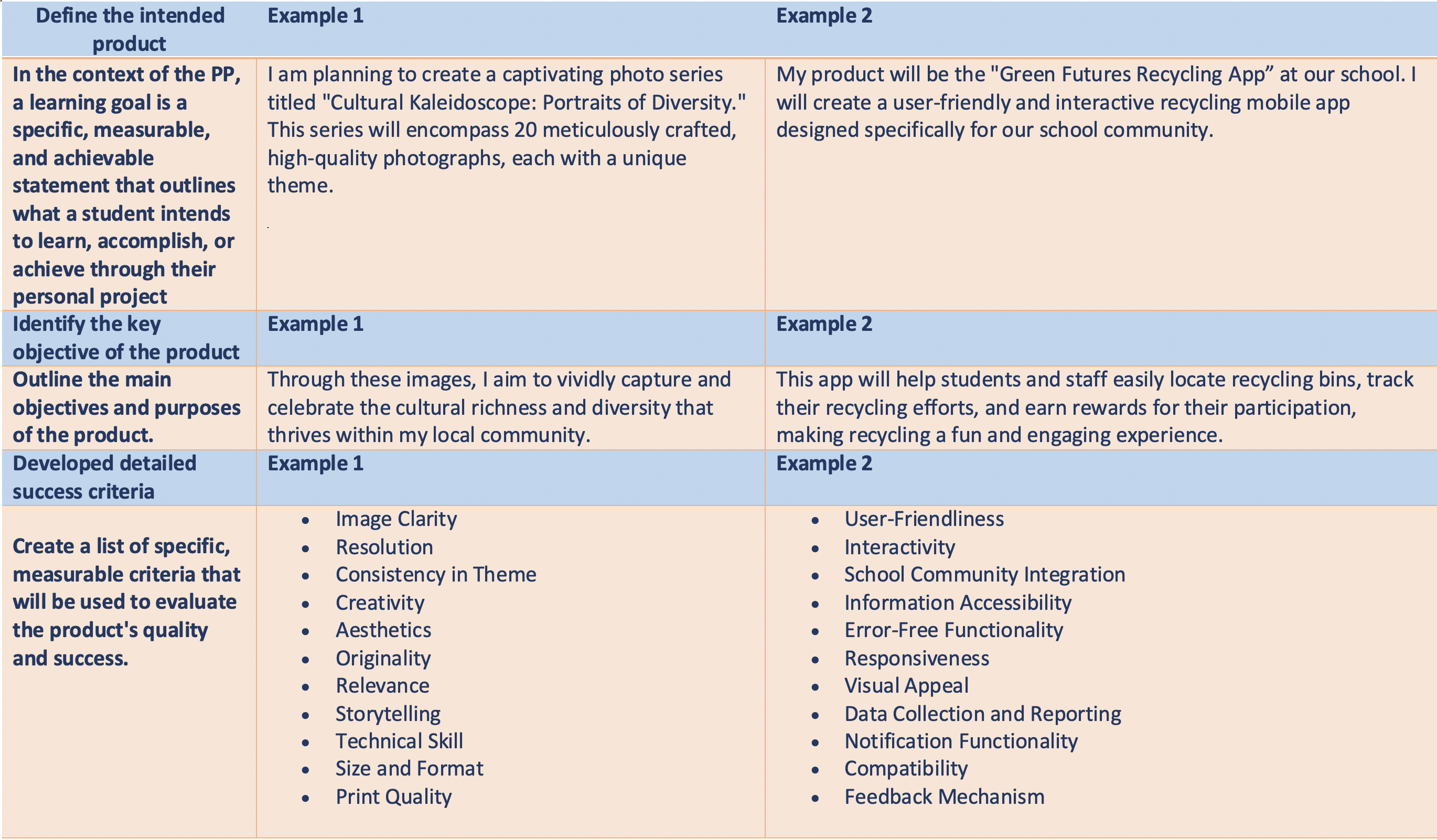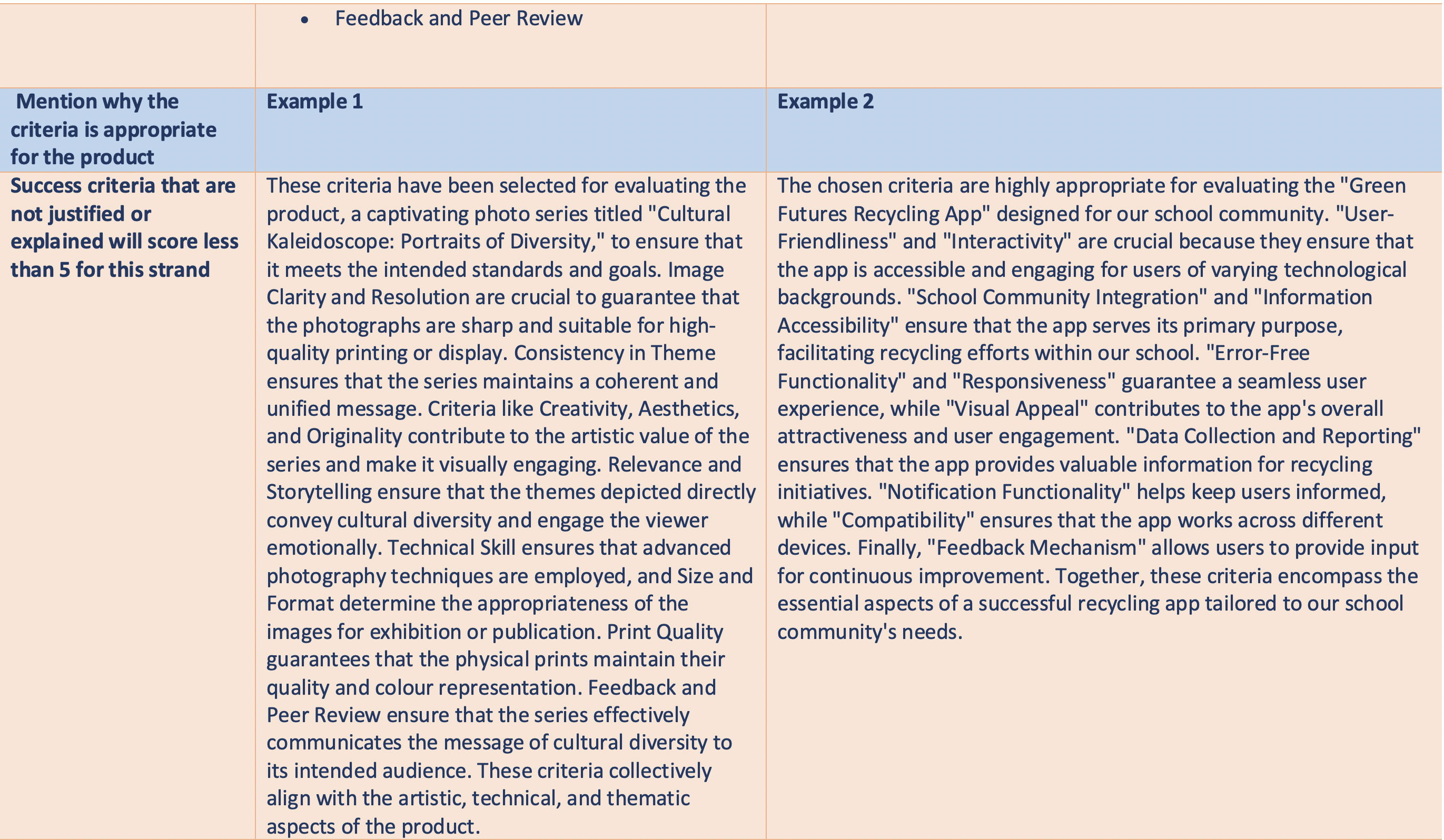Criterion Aii - Product
To achieve 7-8
The student specifies their intended product and provide multiple, well-detailed success criteria for the product.
Describing the Product


Success Criteria Table
Example 1 - "Cultural Kaleidoscope - Portraits of diversity"
| Criterion | Description | Test Method |
|---|---|---|
| Image Clarity | Each photograph should be clear and sharp, with no blurriness or distortion, ensuring well-defined subjects. | Visual inspection of photographs, feedback from peers and experts |
| Resolution | All images must have a high resolution suitable for printing or display, typically 300 DPI (dots per inch) or higher. | Checking image properties and resolution settings using image editing software. |
| Consistency in Theme | Each photograph should align with the unique theme, maintaining consistency throughout the series. | Review by an expert or a focus group to assess thematic consistency. |
| Creativity | The series should demonstrate creative and innovative approaches in capturing the cultural diversity of the local community. | Assessment by experts, peers, or surveying the target audience. |
| Aesthetics | The images should be visually pleasing, with balanced composition, colors, and lighting, adding to the artistic appeal of the series. | Evaluation by art experts, aesthetic principles, and audience feedback. |
| Originality | The series should showcase a fresh and unique perspective on cultural diversity, avoiding clichés or stereotypes. | Expert assessment and feedback from a diverse group. |
| Relevance | The themes of the photographs should relate directly to cultural diversity and effectively convey the message. | Comparison of themes with cultural diversity and feedback from relevant experts. |
| Storytelling | The images should tell a compelling story or evoke emotions related to the cultural aspects presented. | Expert analysis and feedback from the audience to evaluate storytelling effectiveness. |
| Technical Skill | The photographs should demonstrate advanced technical skills in photography, including focus, exposure, and post-processing. | Assessment of technical aspects by photography professionals and experts. |
| Size and Format | The images should conform to a predetermined size and format suitable for exhibition or publication. | Verification of image size and format compliance with exhibition or publication requirements. |
| Print Quality | If printed, the physical prints should maintain image quality, with accurate color representation. | Examination of the printed images for color accuracy and image quality. |
| Feedback and Peer Review | The series should undergo feedback and peer review to ensure it resonates with the intended audience and effectively communicates the cultural diversity message. | Gathering feedback from peers, experts, and target audience through surveys and reviews. |
Example 2 - "Green Futures Recycling App"
| Criterion | Description | Test Method |
|---|---|---|
| User-Friendliness | The app should be intuitive and easy for users to navigate, with clear instructions and minimal learning curve. | User testing and feedback from users. |
| Interactivity | The app should provide interactive features that engage users, such as quizzes, challenges, or rewards for recycling. | Observation of user engagement and participation. |
| School Community Integration | The app should effectively connect and engage the school community, promoting recycling participation among students and staff. | Surveys and data on the number of users from the school community. |
| Information Accessibility | The app should provide access to important recycling information, such as what can be recycled and where to find recycling bins. | Evaluation of the availability and accessibility of information within the app. |
| Error-Free Functionality | The app should function without technical errors, glitches, or crashes that hinder user experience. | Testing the app for technical issues and monitoring user feedback. |
| Responsiveness | The app should respond promptly to user interactions and commands, ensuring a seamless experience. | Testing app responsiveness on different devices and under varying conditions. |
| Visual Appeal | The app should have an attractive and visually appealing design, with an appropriate color scheme and user-friendly layout. | User feedback and assessment of the app's design elements. |
| Data Collection and Reporting | The app should collect data on recycling participation and provide users with reports or statistics on their contributions. | Analysis of data collected and assessment of the reporting features. |
| Notification Functionality | The app should send timely and relevant notifications or reminders to users about recycling opportunities or events. | Observation of notification delivery and user responses. |
| Compatibility | The app should be compatible with a range of devices and operating systems to reach a broader user base. | Testing the app on various devices and OS versions. |
| Feedback Mechanism | The app should include a mechanism for users to provide feedback or report issues for continuous improvement. | Monitoring user feedback and reviews within the app. |
Phrasing your Product
Phrasing your learning goal for a Personal Project should follow a specific structure to make it clear and effective. Here's a suggested way to describe your product
| Aspect of Product | Key Phrases/Words |
|---|---|
| Product Name | Catchy, relevant name |
| Description | Concise summary of the product |
| Purpose | Explanation of its significance |
| Target Audience | Specific user group |
| Features and Functionality | List of key functions/features |
| Unique Selling Points | What sets it apart from others |
| Design | Aesthetic or design elements |
| Materials or Technology | Used materials or technology |
| Size or Format | Physical or digital format |
| User Experience | How users interact with it |
| Benefits | Gains or advantages for users |
| Sustainability | Eco-friendly aspects if applicable |
| Integration | How it fits within its context |
| Accessibility | Ease of access for users |
| Maintenance | Ongoing upkeep or updates |
| Expected Outcomes | Project's objectives and goals |
| Mention how your research skills have informed the choice of the success criteria | |
|---|---|
| Cultural Kaleidoscope: Portraits of Diversity: The success criteria for "Cultural Kaleidoscope: Portraits of Diversity" are deeply informed by thorough research into renowned photography techniques, cultural studies, and the specific themes explored in the photo series. Valuable insights from photography experts and renowned photographers such as Ansel Adams, Dorothea Lange, and Steve McCurry have played a pivotal role in establishing criteria like image clarity and technical skill. Additionally, extensive research into cultural diversity and multiculturalism through reputable sources such as the Pew Research Center, UNESCO, and National Geographic has enriched the success criteria related to creativity, relevance, and storytelling in the series. |
Green Futures Recycling App: The success criteria for the "Green Futures Recycling App" draw from comprehensive research into effective user interface design, eco-friendly technologies, and user-centered app development. Valuable information on user experience (UX) design principles and accessibility guidelines from Nielsen Norman Group and the World Wide Web Consortium (W3C) have directly influenced criteria like user-friendliness and aesthetics. In addition, in-depth research into innovative recycling technologies, waste management systems, and environmental impact assessment from sources such as the Environmental Protection Agency (EPA) and the World Health Organization (WHO) has been instrumental in shaping criteria for functionality, eco-friendliness, and overall environmental impact of the app. |
Exemplars
-
Science:
-
Intended Product: A functional model of a solar-powered water purification system to address clean water scarcity in remote areas.
-
-
Mathematics:
-
Intended Product: A comprehensive interactive mobile app for practicing complex algebraic equations and visualizing geometric theorems.
-
-
History:
-
Intended Product: A documentary film highlighting the untold stories of significant historical events in our region during the 20th century.
-
-
Visual Arts:
-
Intended Product: A series of abstract oil paintings exploring the connection between emotions and color, aiming for an art gallery exhibition.
-
-
Language and Literature:
-
Intended Product: A collection of original short stories that challenge conventional narrative structures and dive into psychological thrillers.
-
-
Physical Education:
-
Intended Product: A comprehensive training program booklet for enhancing core strength and flexibility with a focus on yoga and Pilates techniques.
-
Approaches to learning
When formulating your product and success criteria through research, you demonstrate several approaches to learning (ATL) quality, including:
-
Research Skills: You showcase your ability to conduct in-depth research to inform the product and criteria. This involves efficiently gathering information from various sources, evaluating the credibility of these sources, and selecting the most relevant and valuable data to support your goals.
-
Thinking Skills: You exhibit critical thinking skills by assessing the information you gather. This entails analyzing and synthesizing research findings to determine their applicability to your project. It also involves problem-solving to identify the most effective criteria based on the research.
-
Communication Skills: As you communicate the product's intent and the success criteria derived from research, you are practicing effective communication. This involves conveying complex ideas and concepts clearly and succinctly to others, ensuring your team, mentors, and stakeholders understand the project's direction.
-
Self-Management Skills: Effective research and criteria formulation require planning, organization, and time management. You demonstrate the ability to manage your research process and integrate findings into your project effectively.
-
Social Skills: Collaboration and effective interaction with mentors, experts, and peers during the research process showcase social skills. Seeking input and feedback from others contributes to the quality of your product and criteria.
Learner profile
-
Inquirer: You exhibit curiosity and the ability to conduct in-depth research to gather information that informs your product and success criteria.
-
Thinker: By applying critical thinking and problem-solving skills during the research process, you demonstrate thoughtfulness and intellectual engagement.
-
Communicator: Effective communication is vital when conveying the results of your research, the intent of your product, and the success criteria derived from it.
-
Reflective: Self-reflection is a key aspect of using research to inform your project. You consider the implications of your findings and how they connect to your goals.
-
Open-Minded: Engaging in research allows you to explore various perspectives, fostering open-mindedness.
-
Principled: Demonstrating integrity in your research process and ensuring that the information you use is ethically sourced aligns with the principled attribute.
-
Caring: You may conduct research on topics related to community or global issues, showcasing a caring attitude toward addressing these concerns.
-
Balanced: Achieving a balance between the product's goals and the success criteria, informed by research, is a demonstration of this attribute.
-
Knowledgeable: Gaining knowledge from research and using it to enhance your product and criteria aligns with the knowledgeable attribute.